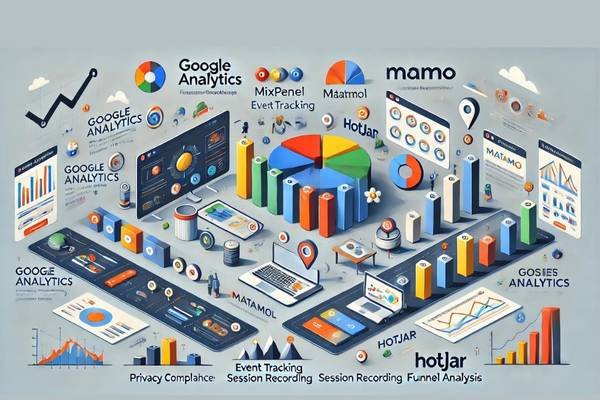
How to Choose the Right Analytics Tool for Your Website
September 28, 2024
Top 7 Free Analytics Tools for Small Business
September 28, 2024Comparing top analytics tools with Google Analytics
In today’s data-driven world, the success of digital marketing campaigns hinges on understanding user behavior and performance metrics. Tracking tools like Google Analytics have become essential for marketers, developers, and content creators, allowing them to optimize strategies and enhance decision-making. But with a range of tracking tools available, it can be difficult to determine which one is right for your business. Should you stick with Google Analytics, or should you consider alternatives like Mixpanel, Matomo, or Hotjar?
This guide dives deep into the features, benefits, and limitations of Google Analytics compared to other tracking tools, helping you make an informed decision based on your specific needs.
Table of Contents
1. Understanding Google Analytics
Google Analytics is a powerful, free tool widely used by marketers to track and analyze website performance. Its comprehensive suite of metrics provides invaluable insights into traffic sources, user behavior, conversion paths, and more.
1.1 Key Features of Google Analytics
- User Behavior Tracking: Google Analytics tracks everything from page views to bounce rates, providing insights into how users engage with your website.
- Goal and Conversion Tracking: Define goals and track conversions to see how visitors progress through your funnel.
- Advanced Segmentation: Slice and dice data by segments such as traffic sources, location, or user behavior.
- Real-Time Reporting: Google Analytics lets you monitor live traffic and conversions, offering instant insights into ongoing campaigns.
- Audience Insights: It provides demographic data, such as age, gender, and interests, to help refine marketing strategies.
1.2 Benefits of Using Google Analytics
- Free to Use: It offers robust features for free, making it ideal for small businesses and individuals.
- Google Integration: Seamlessly integrates with Google Ads and other Google services for comprehensive data.
- Custom Reporting: Create custom reports tailored to your specific needs, allowing for greater control and precision in data analysis.
- Widespread Support: There are plenty of tutorials, forums, and third-party plugins available for Google Analytics, ensuring you have access to extensive resources.
1.3 Limitations of Google Analytics
Despite its popularity, Google Analytics has limitations, particularly for businesses looking for granular or event-based tracking. It also may have a steeper learning curve for those unfamiliar with complex data reports.
- Sampling Issues: Google Analytics applies data sampling in reports, which can lead to inaccuracies, especially with large datasets.
- GDPR Compliance: The default configuration of Google Analytics doesn’t align with GDPR and other privacy laws, requiring additional setups.
- Lack of Event-Driven Analytics: While it can track events, the process isn’t as intuitive as dedicated event-based tracking tools like Mixpanel.
2. Comparing Google Analytics with Other Tracking Tools
While Google Analytics is widely regarded as the go-to tracking tool, there are several alternatives that may provide more specialized insights, depending on your needs.
2.1 Mixpanel
Mixpanel focuses on event-based tracking, making it ideal for businesses that need to understand user behavior beyond just page views.
2.1.1 Key Features of Mixpanel
- Event-Based Analytics: Instead of sessions or page views, Mixpanel tracks individual events (e.g., clicks, downloads, and video plays).
- Cohort Analysis: Track specific groups of users over time to analyze their engagement or conversion rates.
- Funnel Analysis: Mixpanel makes it easy to build, visualize, and optimize your conversion funnels.
- A/B Testing: It integrates seamlessly with A/B testing, helping teams optimize user experiences.
2.1.2 Advantages of Mixpanel
- Real-Time Data: Mixpanel provides live data updates without delays, perfect for fast-paced environments.
- Advanced Segmentation: Its advanced segmentation capabilities are unmatched, offering detailed insights into different user behaviors.
- No Data Sampling: Unlike Google Analytics, Mixpanel doesn’t apply sampling to its reports, giving you exact data.
2.1.3 Disadvantages of Mixpanel
- Cost: While Mixpanel offers a free plan, its advanced features are locked behind a paywall.
- Steep Learning Curve: Its focus on events and user behavior means that you may need more time to set up and optimize Mixpanel effectively.
2.2 Matomo (formerly Piwik)
Matomo is an open-source alternative to Google Analytics, which emphasizes privacy and full control over data.
2.2.1 Key Features of Matomo
- GDPR Compliance: Matomo offers built-in tools for GDPR compliance, making it easier for EU-based businesses.
- Self-Hosting Option: You can self-host Matomo, giving you complete control over your data.
- No Data Sampling: Like Mixpanel, Matomo does not sample data, providing more accurate insights.
- Heatmaps and Session Recording: Track how users interact with specific elements on your website through heatmaps.
2.2.2 Advantages of Matomo
- Complete Data Ownership: If you host Matomo on your servers, you own the data entirely.
- Highly Customizable: Being open-source, Matomo allows for extensive customization, which makes it flexible for various business models.
- Privacy-Focused: Matomo puts privacy at the forefront, perfect for organizations concerned with compliance and security.
2.2.3 Disadvantages of Matomo
- Complex Setup: For those unfamiliar with server management, self-hosting Matomo can be complicated.
- Costs for Advanced Features: The self-hosted version is free, but hosted solutions and advanced features can become costly.
2.3 Hotjar
Hotjar focuses on user interaction, providing qualitative insights through heatmaps, session recordings, and surveys.
2.3.1 Key Features of Hotjar
- Heatmaps: See where users click, scroll, or spend the most time on your pages.
- Session Recordings: Watch recordings of real user sessions to understand how users navigate through your site.
- Surveys and Polls: Get direct feedback from users via pop-up surveys or polls.
2.3.2 Advantages of Hotjar
- Qualitative Insights: Hotjar provides insights that Google Analytics cannot, such as why users leave a page or what frustrates them.
- Ease of Use: Its interface is intuitive, making it easy to set up and start collecting data quickly.
- Data Visualization: Hotjar offers clear visualizations, allowing teams to make quick adjustments.
2.3.3 Disadvantages of Hotjar
- Limited Quantitative Data: While it excels at qualitative data, Hotjar doesn’t provide deep metrics like Google Analytics.
- Not a Comprehensive Tool: Hotjar works best as a supplement to other analytics tools, rather than a standalone solution.
3. Choosing the Right Tool for Your Needs
3.1 When to Use Google Analytics
If you are looking for a free, robust tool that integrates seamlessly with Google products and gives you a broad overview of user behavior, Google Analytics is the go-to option. It’s best suited for businesses that need comprehensive traffic reports and don’t require advanced event-based tracking.
3.2 When to Use Mixpanel
If your primary concern is tracking user interactions and behaviors within your app or website, Mixpanel is the better choice. It excels in event-based tracking and provides detailed insights into how users engage with your product, making it ideal for SaaS businesses and developers.
3.3 When to Use Matomo
For businesses that prioritize data privacy and ownership, or those that operate in countries with strict data protection laws, Matomo is a powerful alternative. It’s also a good option for those wanting customizable, unsampled data.
3.4 When to Use Hotjar
For marketers, UX designers, or content creators looking to understand how users interact with individual elements on their site, Hotjar provides invaluable qualitative insights. It works well in tandem with a comprehensive tool like Google Analytics.
Comparing top analytics tools with Google Analytics Recap
| Tool | Key Features | Best For | Limitations | Website |
|---|---|---|---|---|
| Google Analytics | Traffic analysis, goal tracking, audience insights | General website analytics | Sampling issues, limited event tracking | Visit |
| Mixpanel | Event-based tracking, funnel analysis, A/B testing | Event and behavior tracking | Costly advanced features | Visit |
| Matomo | GDPR compliance, self-hosting, unsampled data | Data privacy and ownership | Complex self-hosting setup | Visit |
| Hotjar | Heatmaps, session recordings, surveys | UX and user behavior analysis | Limited quantitative data | Visit |
Frequently Asked Questions
1. Is Google Analytics free to use? Yes, Google Analytics offers a free version with powerful features suitable for small to medium-sized businesses. However, Google Analytics 360 is available for enterprises that need additional functionality.
2. Can Google Analytics track events like button clicks? Yes, Google Analytics can track events such as button clicks, but the setup is not as intuitive as tools like Mixpanel, which specialize in event-based tracking.
3. Is Matomo better for privacy than Google Analytics? Yes, Matomo prioritizes privacy and offers better control over your data, especially with its self-hosting option, making it a more compliant option for GDPR and other privacy regulations.
Conclusion
When it comes to choosing the right analytics tool, it all boils down to your specific business needs. Google Analytics remains a popular choice due to its powerful features and seamless integration with other Google products. However, alternatives like Mixpanel, Matomo, and Hotjar offer specialized features that may be more suitable for businesses focusing on event-based tracking, data privacy, or user experience.
By understanding the strengths and limitations of each tool, you can make an informed decision that aligns with your business goals and helps you unlock deeper insights into your digital performance.








